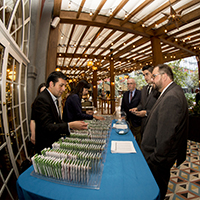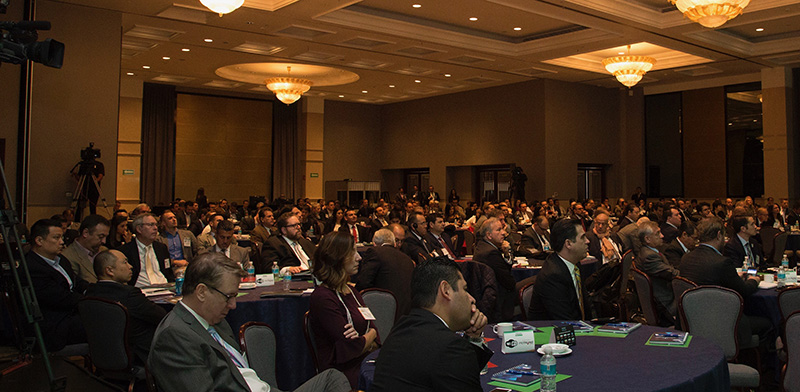 While a degree of uncertainty over the future of free trade between Mexico and its Nafta neighbours to the north once again hung over discussions at this year’s Automotive Logistics Mexico conference, it was more than matched by confidence in the future of the automotive sector. That confidence is being fed by optimism about the next generation of engineering and logistics talent and the transformation of the supply chain through digital technology.
While a degree of uncertainty over the future of free trade between Mexico and its Nafta neighbours to the north once again hung over discussions at this year’s Automotive Logistics Mexico conference, it was more than matched by confidence in the future of the automotive sector. That confidence is being fed by optimism about the next generation of engineering and logistics talent and the transformation of the supply chain through digital technology.
Mexico made 3.8m vehicles last year, an increase of almost 9% compared to 2016, and the forecast for 2020 is for 5m units. The SUV and premium segments are on the increase, and the majority of its output is exported: of total production, 3.1m vehicles were exported last year, up 12% on 2016.
The digitalisation of manufacturing and logistics processes underpinning that export-based growth is developing in a number of different areas at different rates in Mexico. While seen as the solution to a number of problems in the country’s vehicle sector, including lower tier fragmentation, infrastructure development (or the lack of it) and the currently high turnover of labour, the majority of those canvassed in a conference poll (57%) about its take-up said Mexico was at risk of falling behind the rest of the world.
“The question becomes, when you have all these sources of unpredictability and variability, how do you really leapfrog to the next level? And that is where digital comes in,” said Sven Dharmani, global auto supply chain leader at professional services provider, Ernst & Young.
There is good scope for the application of digital capabilities in solving problems related to track and trace, supplier manufacturing on a just-in-time and just-in-sequence basis, and studying supply chain risk including disruption and theft, according to Dharmani.
Ernst & Young is collaborating with logistics provider Penske on some digital track and trace initiatives, including how to get early indication of potential disruption in the supply chain and how to respond to it.
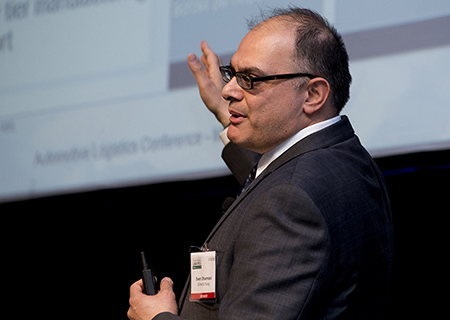
Dharmani said Mexico had the advantage of being in the Nafta region with relatively short transit and lead times compared to offshore resources.
“This is where the value comes in, in applying some of these technologies, including smart sensors, the Internet of Things (IoT) and deep learning, and integrating them into one value chain,” he said.
According to Dharmani the ‘nirvana’ for this technology uptake would be the establishment of an autonomous value chain that sensed change either from the demand side, when a customer changed an order, or on the supply side, when something like a fire stopped production at a supplier’s factory.
Digital from the startWhile the supply chain is a long way from being autonomous in Mexico, premium carmakers are already employing digital technology at their plants to make production and logistics more efficient, while also maintaining visibility over both incoming parts and outgoing finished vehicles.
Audi built completely new systems into its plant at San José Chiapa when it set up operations in September 2016 to make the Q5. It is the carmaker’s first plant outside of Germany and digital technology has been made central to its logistics processes, according to Peter Koltai, director of production control and logistics at Audi Mexico.
Audi has its own trailer yard adjacent to the plant for the receipt of parts shipped from the North American region and receives 315 trailers a day. It also has a container yard receiving 246 TEUs per week, explained Koltai. At both of these, the carmaker is using a steering system and telematics control which means it can unload from the yards according to production demand.
Audi takes in around 3,500 small packages of parts and around 700 bigger stillages (GLTs) a day. “We have a live monitor and digital control over the operations of the goods-in area and we have permanent control of the material flow, the goods received and their placement in the storage area,” explained Koltai.
 Peter Koltai, director of production control and logistics at Audi Mexico
Peter Koltai, director of production control and logistics at Audi MexicoThe company employs RFID tags in its packaging so all of the packages can be identified at checkpoints throughout the factory.
Asset trackingKeith Schall, director of technology solutions at Chep, said unique identification of items through individual track and trace technology such as RFID was previously seen as a luxury but was now regarded as a basic requirement. The primary driver for that need was loss prevention and having better accountability of available assets, or, as he put it, having “the right asset in the right place at the right time”.
Schall said Chep’s customers and suppliers were mandating a tracking system be in place on parts shipped to them, whether that system was their own or one provided by Chep. Better accountability clearly is an important factor in a country with an enduring theft and vandalism problem, as is compliance with accounting standards.
Barcoding and passive RFID have been around for a long time but there are now smart and active (and more expensive) systems coming into play that link the RFID data to the IoT via handheld and vehicle on-board technology. The information gathered and the use of predictive analytics could solve a range of issues, according to Schall, such as potential production shortages.
“What if we could take all of that information and use predictive analytics to reroute the load in the instance when another shipment is not going to make it on time?” he asked.
Smarter coordination of inbound material is certainly something Ford is looking for in its Mexico operations. Rafael Lopez, material planning and logistics director at Ford Mexico, said the company wanted the logistics outside of its plant to be as synchronised as that within it.
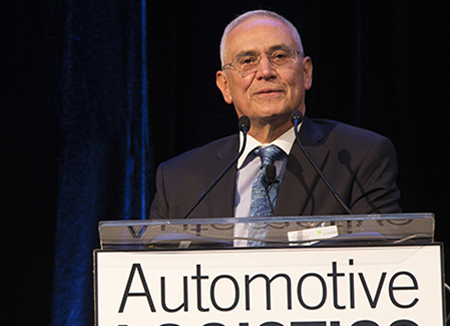 Rafael Lopez, material planning and logistics director at Ford Mexico
Rafael Lopez, material planning and logistics director at Ford Mexico“We have seen we are good at synchronising our logistics chain inside the plant but the question is: how to synchronise it outside as well for the inbound supply of parts?” he said.
Using IoT for smarter inbound transport is also something Ryder is looking at across North America. Ricardo Alvarez, director of solutions and business development at Ryder México, said his company was testing the technology as it applied to transport management and incorporating the discernible benefits into its transport management system (TMS).
“Bringing sensors and telematics, and cloud computing, will enable us to track each mode in the supply chain and provide real-time data on all assets, which could include warehouses, transport units, roads and people,” said Alvarez. “The main benefits we see in incorporating this technology into our TMS is that we will be optimising the assets of our carriers and we will generate higher operational efficiencies, providing visibility. But it will also enable us to monitor the condition of the goods that are being transported.”
That, he said, could help manage risk and avoid congestion or dangerous routes.
Global parts flowAt the end of the day, said Schall, it is important to assess what type of assets you are trying to track and the environment in which they are being tracked, but the tagging of the assets is probably the most important step in the process. Maintaining a permanent focus on inventory processes, he said, was crucial.
That is certainly the case at Audi, according to Koltai, given the range of parts it has coming in from different regions of the world. Audi uses parts in Mexico from 170 suppliers in North America (the majority of them in Mexico itself) and 350 suppliers in Europe, as well as a number in Asia. All of those parts are scanned into its warehouse system. “We can always prove that everything is where it should be and with that in place, we have practically no deviation; it is 99.99% accurate,” asserted Koltai.
From there, Audi uses a digital route planning system from its trailer station, monitoring on-time delivery of the parts to the line side with a 97% punctuality rating. For each car, the company is delivering 21 small packages and 7 GLTs, all of which are digitally tracked to the point of use.
For sequencing and kitting, Koltai explained, Audi was using pick-by-light and pick-by-voice systems, with 178 picks per vehicle from 130,000 parts.
[mpu_ad]“With the supporting systems we have achieved a 55ppm [parts per minute] rate that we believe is a good rate for a factory that has recently started serial production,” he said.
Inbound transparencyBMW is another premium carmaker committed to production in Mexico, though this does not begin until the first quarter of 2019 at the plant nearing completion in San Luis Potosi. Nevertheless, there is similar attention being paid to the importance of inventory control and what the latest digital technology can do to help maintain control over a huge variety of parts coming in from different parts of the world.
“We strive for full transparency on the inbound supply chain,” explained Karl-Friedrich Koch, BMW’s vice-president of production control and logistics at the plant.
Koch said logistics was part of delivering an uncompromising focus on product quality. “The BMW customer wants to have a premium car regardless of where it is made. Logistics is part of this and superior part quality over the global inbound supply chain, and within the plant, must be excellent.”
BMW is setting up an integrated system for order-to-delivery of inbound parts that will allow it to track and trace those parts throughout the entire process from the supplier to lineside, according to Koch. The technology the company will be applying at the factory will identify and visualise the inbound parts and then analyse and predict the requirements for production, based on what is in stock or on its way to the factory.
“We can then act and optimise so that we are prepared if we have major changes in the orders or if we have disruption at the port or through adverse weather events,” said Koch. “We have contingency measures one or two weeks ahead and a plan of how to cope.”
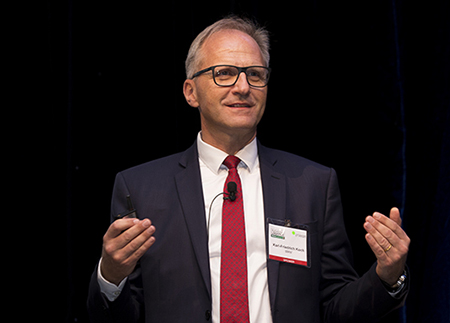 Karl-Friedrich Koch, vice-president of production control and logistics at BMW's San Luis Potosi plant
Karl-Friedrich Koch, vice-president of production control and logistics at BMW's San Luis Potosi plantOutbound visibilityQuality is as important on the outbound side. Koch said it was also important that risk of damage was reduced here and digital technology would play its part.
“We want digital control of the outbound supply chain,” he said. “We want to bring in connected distribution, and full transparency track and trace of the finished vehicles from San Luis Potosi to the distribution areas and up to the final customer. We want to track each vehicle and know where it is, but also have condition monitoring to see whether the cars have been opened or damaged, and have the full information available digitally.”
BMW will doing that for the 175,000 vehicles a year it will initially produce at the plant for global distribution.
Outbound visibility is something Audi is also already implementing, with the use of RFID for yard management at its loading facilities. The carmaker is using the technology to keep track of vehicles ready for loading onto either rail or truck. Koltai said Audi was loading 580 cars a day onto rail for the ports and the border with the US, as well as loading around 150 cars a day onto truck.
So far, the Audi plant has produced 158,550 Q5 units for global distribution. Koltai said the company was now working on a universal control tower to optimise visibility of the whole supply chain.
Competitive warehousesA smarter supply chain supported by easier access to digital technology also offers the chance of enormous improvement in warehouse management, according to Ryder’s Ricardo Alvarez. He said warehouses should be more than just cost centres and that Ryder wanted to transform them into assets that provided competitive advantage.
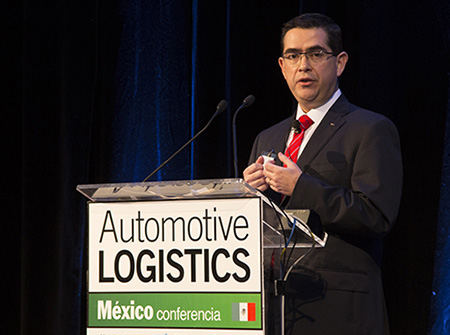 Ricardo Alvarez, director of solutions and business development at Ryder México
Ricardo Alvarez, director of solutions and business development at Ryder MéxicoCiting the MHI Annual Industry Report 2017, Alvarez pointed out that 92% of the 1,100 professionals that responded to the survey behind the report said technology was going to make the difference in the transformation of the warehouse.
Ryder is focusing on four innovations it thinks will make a difference in the near future, namely automation (including autonomous vehicles), sensors, wearable technology and the use of drones in its distribution centres. Alvarez said it was with those technologies that it could deliver the key attributes defining the smart warehouse, adding that what was important amongst those attributes was the ability to know what to automate.
“You should be automating where it makes sense. It is not just about replacing labour with technology, it is about finding the right balance between technology, skilled labour and available resources,” he said.
Complex but dependableBMW is using technology to make its complex logistics processes in Mexico more “dependable” among staff who may not be as qualified as others in the carmaker’s processes, though the business case for a full digital plant with autonomous technology is not strong enough yet, according to Koch, given that labour costs remain low.
Nevertheless, the company has a model factory for training and is employing ‘gamification’ – game playing rules used to encourage engagement in learning new tasks – to train staff in the complexity of its logistics processes.
The training of people involved in the logistics of premium brands is a major undertaking in Mexico at the moment. Schnellecke Logistics, which provides services for both Audi and BMW, is using virtual training simulators for its staff implementing the sort of systems underpinning the supply of materials to premium carmakers in the country.
Using digital technology in training is something that appeals to the new generation of engineers, according to Schnellecke’s vice-president of operations in Mexico, Volker Vossler, who also highlighted the use of gamification and digitalisation in that process.
Retaining staff is as big an issue as training them in the first place. Staff turnover in manufacturing plants in Mexico is around 30%, according to figures from Ernst and Young’s Sven Dharmani. Training, he said, was key to retention and augmented reality was now being used for that training.
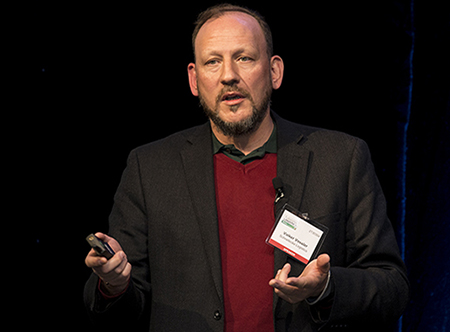 Volker Vossler, vice-president of operations in Mexico for Schnellecke
Volker Vossler, vice-president of operations in Mexico for SchnelleckeEngaging new talent was the most promising thing for the future of the industry in Mexico, according to Joe Carlier, senior vice-president of global sales at Penske, especially given that generation’s embrace of new technology.
“We all know that in the supply chain, one of the biggest challenges we are going to be faced with is around talent,” he said. “The enthusiasm and quality of the students can only really help advance the industry. There may be challenges now but for the future, I am extremely optimistic. My experience is that those we have invested in, we have kept, and that nurtures greater retention.”
Near-term pressuresMeanwhile, carmakers and their logistics providers in Mexico continue to tackle the perennial problems of rail and port capacity, especially at Veracruz, and the migrating crisis of theft and vandalism, which is now also affecting the Veracruz region.
Audi’s Koltai said one of its two priorities this year was solving the bottleneck at Veracruz. The carmaker is planning to move some of its outbound volume through Tuxpan port to the north, now the highway linking the port to the network has been completed. BMW’s Koch said it, too, was looking at alternatives but would be revealing its choice in 2019 ahead of the start of production at San Luis Potosi.
“What we recognise is that there are plans to increase capacity at Veracruz but the reliability of the date and schedule is in question,” said Koch. “We have a strict production schedule and, if the port developments are delayed, that is not acceptable to us.”
Ford’s Lopez said that port capacity and development were also a priority for him and that the carmaker was looking for more development at ports on the Pacific side of the country. He said Ford was already exporting out of Mazatlan port but that huge improvements were possible there. New rail routes and capacity and more security in the logistics network were also key concerns in the short term, according to Lopez.
In the long term, however, speakers at this year’s conference concurred on the whole that, while the political wrangling over trade going on in Canada would take its course, there were definite technological developments going on in the establishment of a digital supply chain that would ensure Mexico’s automotive sector continued to grow its role in feeding the global trade in vehicles.
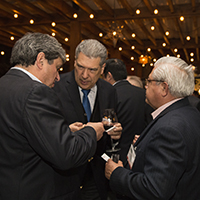


Automotive Logistics Mexico is part of the global Automotive Logistics series of conferences

























![Global[1]](https://d3n5uof8vony13.cloudfront.net/Pictures/web/a/d/s/global1_726550.svgz)






